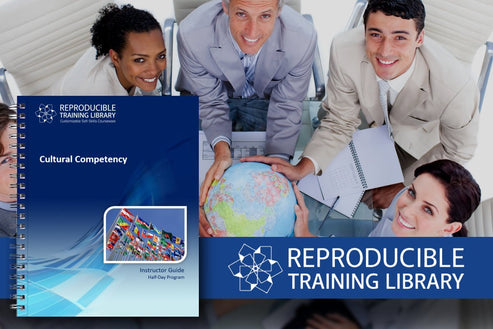Share
How to Improve Cultural Competence in the Workplace
Bradford R. GlaserWith globalization and technology on the rise, the workplace is becoming more diverse and more connected than ever before. In the U.S., groups once considered “minorities” will combine to comprise more than half of the population by 2045. Plus, technological capabilities are now providing greater ease of remote working, allowing colleagues to work from all over the world. The need for greater cultural awareness among people and cultural competence training has never been stronger.
The growing number of cultures and perspectives in the workplace can pose challenges to collaboration and teamwork if not constructively addressed. The more employees can understand and empathize with one another, the more productive they can be. We call this cultural competence, and in this post, we’ll walk you through some ways you can improve cultural competence in your organization.
Let's get started!

- Identify elements of cultural competency
- Practice respectful interactions
- Support cultural competency
Table of Contents
What Is Cultural Competence?
Cultural competence refers to your organization’s collective knowledge and understanding of different cultures and perspectives. It’s a measure of your workforce’s ability to work with people of different nationalities, ethnicities, languages, and religions.
Cultural competence is inherently difficult to quantify and measure. Ensure you're setting employees up for success by first understanding where they’re coming from, then equipping them with the knowledge and skills necessary to operate globally.
Understanding Cultural Competency
Cultural competence comprises a few different dimensions. Consider the following when assessing and working to improve the state of your workplace:
- Sensitivity: This component refers to an individual’s ability to understand and appreciate cultural differences – in other words, how “sensitive” a person is to differences.
- Awareness: Awareness is linked to one’s ability to understand how culture can affect thinking, behavior, and interactions.
- Skills: Once an individual can appreciate differences and understand how those cultural variations affect how we interact with the world. Skills are then reflected in their ability to communicate and interact across cultures effectively.
The Role of Leadership in Driving Cultural Competence
Cultural competency requires more than just good intentions; it requires visible commitment, starting from the top. When leaders model curiosity, empathy, and respect for different perspectives, it sets an example for others to follow. Without the commitment from leadership, even the most well-designed training initiatives can fall flat.
Where Do I Start?
The most effective place to start is to assess your organization’s base level of cultural competence. Whether you hire a diversity consultant to get an understanding of where your workforce is or use an assessment tool like our Cross-Cultural Adaptability Inventory, the key is to make sure you’re approaching this journey from a place of understanding. Work to figure out where your employees are on their cultural awareness journey, then have a productive conversation and set tangible goals.
Embedding Cultural Competency
Developing and maintaining sensitivity, awareness, and cross-cultural skills takes ongoing effort. Once you initiate your training and communication, here are some ideas for keeping the conversation going:
- Build and maintain a global holiday calendar: Create a shared, collaborative calendar for employees to contribute to and fill out. This makes everyone aware of global holidays, especially those specific to different cultures and religions. For example, while Christmas and Thanksgiving may lie at the heart of Christian-centric American culture, holidays like Yom Kippur, Diwali, and Eid al-Fitr are all canonical to customs worldwide. Inviting employees to share these critical events helps engage your workforce, and keeping this calendar is a great way to show employees that you respect their important holidays.
- Develop employee affinity groups: Creating opportunities for employees to network, connect, and share common ground outside of job-specific subjects helps build stronger connections and encourages individuals to bring their full selves to their jobs. Employee affinity groups help people with common cultures and backgrounds connect and celebrate their individuality. It also encourages these same people to involve others in their culture and identity, creating organization-wide conversations.
- Continue to educate: This means staying current on diversity trends, sharing information about culture, and regularly engaging in cultural competency workshops. Creating an online platform where employees can share the latest news, styles, and cultural currency regarding their unique identity may also be helpful. This is a great way to foster an organic dialogue where people feel comfortable sharing more about themselves.
- Set goals and solicit feedback often: As an organization, hold yourself accountable for embedding cross-cultural exchanges and promoting diversity in all facets. Work with employees to create KPIs for diversity and inclusion success from the start. Examples may include holding x number of cultural events per year, starting x number of employee affinity groups, aiming for high employee satisfaction metrics, etc. Make this an ongoing conversation by sending out regular surveys, allowing employees to give feedback and suggestions. Remember, this is all about inclusion. The more employees feel included, heard, and valued as part of this evolution, the more satisfaction and engagement you can see.
Get Started with HRDQ

HRDQ’s Cultural Competency Customizable Courseware walks you through this entire process. This cultural competence training will help participants identify elements of cultural competence in the workplace to increase their understanding of culture and perceptions of other cultures. Highlight three dimensions of cultural awareness and help employees develop the skills needed to practice respectful and empathetic behavior toward cultures of all creeds in the workplace.





















































